 |
 |
 |
 |
 |
 |
 |
 |
 |
 |
 |
 |
 |
 |
 |
 |
 |
 |
 |
 |
 |
 |
 |
 |
 |
 |
 |
 |
 |
 |
 |
 |
 |
 |
 |
 |
 |
 |
 |
 |
 |
 |
 |
 |
 |
 |
 |
 |
 |
 |
 |
 |
 |
 |
 |
 |
 |
 |
 |
 |
 |
 |
 |
 |
 |
 |
 |
 |
 |
 |
 |
 |
 |
 |
 |
 |
 |
 |
 |
 |
 |
 |
 |
 |
 |
 |
 |
 |
 |
 |
 |
 |
 |
 |
 |
 |
 |
 |
 |
 |
 |
 |
 |
 |
 |
 |
 |
 |
 |
 |
 |
 |
 |
 |
 |
 |
 |
 |
 |
 |
 |
 |
 |
 |
 |
 |
 |
 |
 |
 |
 |
 |
 |
 |
 |
 |
|
|
Return to the Solving Problems Through Force Main Page |
|
|
|
Notgeld During WWI |
|
|
|
The mere threat of war caused financial chaos across Europe during the last week of July. As individuals began hoarding money, local governments and private businesses were forced to introduce short-term certficates to make up for the shortage of small change. Thus, German communities introduced Notgeld (emergency money) into circulation, often with an expiration date. Response to the impending war was swift. Some communities actually issued notgeld before the war even began (see Preussisch Holland, below). Issuance occurred not only in Germany, but also in Austria-Hungary, Belgium, France, Russia, Poland, etc. There was a break in the wave of issues in Germany at the end of 1914. However, the massive numbers of POWs caused the need for moeny for those prisoners... See POW Lagergeld next. |
|
|
|
Click on images for larger pics! |
|
|
|
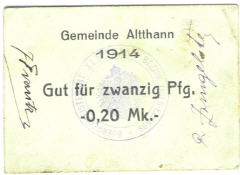 |
|
|
|
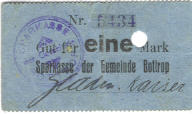 |
|
|
|
|
|
Bottrop, Rhein Provinz in Prussia. Issued in 1914. This town was known as the "biggest village in Prussia," but today is called the "Smallest city in Germany." Most inhabitants worked in its coal mines. |
|
|
|
|
Altthann, in Alsace-Lotharingia. Issued in 1914. A simple and functional cardboard issue. |
|
|
|
|
|
|
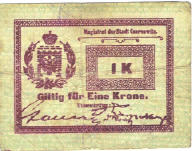 |
|
|
 |
|
|
|
|
|
Crone, Provinz Posen in Prussia. Issued on 6 August 1914, on stiff, inflexible cardboard. Holepunch denotes cancellation. |
|
|
|
|
|
|
Czernowitz, Bukowina. One of five values. Issued shortly before the first Russian Occupation, Sept. 1914. |
|
|
|
|
|
 |
|
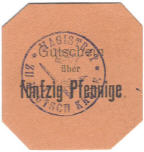 |
|
|
|
|
"God is with us!" claims an issue from Deutsch Eylau, East Prussia. This city was the intended meeting point of the Russian armies of Rennenkampf and Samsonow during their invasion of East Prussia in Aug. 1914. The Battle of Tannenberg saved Deutsch Eylau and the German effort on the Eastern Front. |
|
|
|
|
|
|
Deutsch Krone, West Prussia. Town located on the critical road from Berlin to Danzig. |
|
|
|
|
|
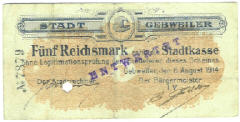 |
|
|
|
|
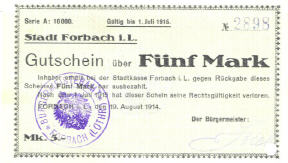 |
|
|
|
|
|
|
Gebweiler, Upper Alsace. Issued on August 6, only a week before the French occupied the town. The French were expelled from Gebweiler a few days later, not to return until after the armistice. |
|
|
|
|
Forbach, Issued in Lotharingia shortly after the French "Plan XVII" scheme for the invasion of Lotharingia ground to a bitter halt. |
|
|
|
|
|
|
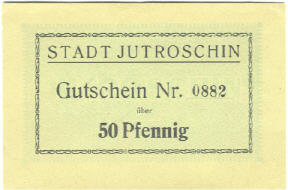 |
|
|
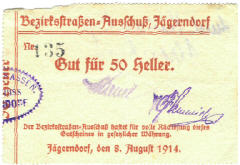 |
|
|
|
|
|
|
Jägerndorf, Austrian Silesia. Issued in August, 1914, but counterstamped with "27. Nov. 1917" in red on the back |
|
Jutroschin, Provinz Posen in Prussia. Issued in August, 1914 and similar to issues from dozens of nearby towns, including Ostrowo and Tremessen. |
|
|
|
|
|
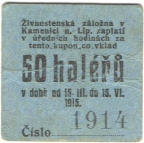 |
|
|
|
 |
|
|
|
|
|
Kamenice, Bohemia. This was the second issue for early 1915. |
|
|
|
|
Kamenice, Bohemia. This was the firstissue for late 1914. |
|
|
|
|
|
|
 |
|
|
|
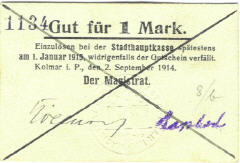 |
|
|
|
|
|
Kayserberg, in central Alsace. Heavy cardboard issue for a heavily contested region of the Vosges mountains. |
|
|
|
Kolmar, Provinz Posen in Prussia. Issued Sept. 2, 1914 and expired on Jan. 1, 1915 |
|
|
|
|
|
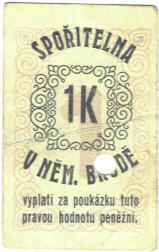 |
|
|
|
|
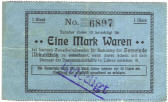 |
|
|
|
|
|
Mikultschütz, Upper Silesia, issued in 1914. This town was the scene of some gruesome hand-to-hand fighting in spring 1921 between the German Freikorps and the Polish Korfantyist insurgents. |
|
|
|
|
|
|
Nemecky Brod, or Deutsch Brod, in Bohemia. In spite of its German name, there were probably few Germans there. The nearest Germans were in the so-called Iglau island in the middle of the modern Czech Republic. |
|
|
|
|
 |
|
|
|
|
|
|
 |
|
|
|
Neveklov, Bohemia. An issue from 1914 on rectangular cardboard, typical for the central and northern issuing towns in Bohemia. |
|
|
|
Nikolai, Upper Silesia. A mining and manifacturing town caught in the throes of civil strife in the early 1920s, eventually handed over to Poland even after a plebiscite decided for Germany. |
|
|
|
|
|
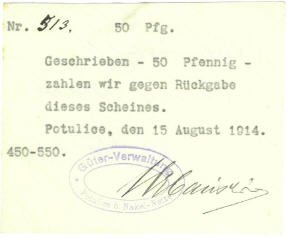 |
|
|
|
 |
|
|
|
|
|
Preussisch Holland, East Prussia. Issued 1 August, 1914, the day Germany declared war on Russia. This issue was obviously prepared before war had begun. |
|
|
|
|
Potulice, Provinz Posen in Prussia. Issued Aug. 15, 1914. Common style of typewriter issues from early in the war. |
|
|
|
|
|
|
 |
|
|
|
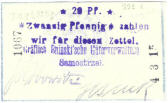 |
|
|
|
|
|
Samostrzel, Province Posen in Prussia. Issued by a private concern in the neighbourhood. |
|
|
|
|
Roppenzweiler, Alsace. Issued by a textile firm in December 1914, with its original control tab still intact. |
|
|
|
|
|
|
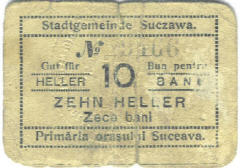 |
|
|
|
 |
|
|
|
|
|
Sulz, Upper Alsace. Like Gebweiler, this note carries the distinctive "reichsmark" designation, unlike other issuers including the Central Bank.. Probably, it was a political calculation, considering how Alsace was an object of contention throughout the war. |
|
|
|
|
Suczawa, Bukowina. Issued in September, 1914. Suczawa was not occupied by the Russians until July 1916. |
|
|
|
|
|
|
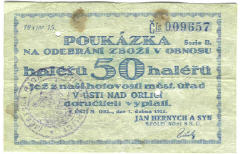 |
|
|
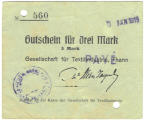 |
|
|
|
|
|
Thann, Upper Alsace. Issued by a textile company in September, 1914 but counter- stamped for Jan. 1915. Like Weiler (below), Thann was occupied by the French and held throughout the war. |
|
|
|
|
|
|
Usti nad Orlici, northeastern Bohemia. This note was ciculated in early 1915. It sat on the edge of the Sudetenland, where the German-speaking people of Bohemia and nearby Moravia lived. Usti had a mostly Czech-speaking population, though. |
|
|
|
|
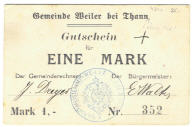 |
|
|
|
|
|
|
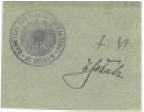 |
|
|
|
|
Weiler, Upper Alsace. Issued early August, 1914. The town was occupied very early on by the French and held throughout the war. Afterward, it was annexed to France; note the counterstamp on the back of this note. |
|
|
|
|
|
|
Zerkow, Province Posen in Prussia. A simplistic note issued in autumn 1914, valued at 10 pfennig. |
|
|
|
|
 |
|
|
|
|
|
|
Znin, Province Posen in Prussia. This issue has been cancelled by hand. Note the word "Entwertet" scribbled at the top. |
|
|
|
Lagergeld, 1914-1918 |
|
|
|
Beginning with the invasion of northern France and the victory of Tannenberg, hundreds of thousands of POWs fell into the Germans' hands. Subsequent battles would net the Germans and Austrian many millions of Entente prisoners. This necessitated the creation of a monetary system for the camps. Beginning in 1915, many dozens of camps operated both by Army Corps and by industries would produce Kriegsgefangenlagergeld, until the end of WWI... |
|
|
|
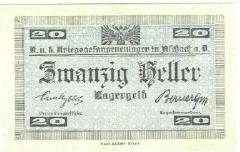 |
|
|
|
 |
|
|
|
|
|
Issue from a workshop operated by the Vulkan Company, Bremen, a target of Entente aircraft. |
|
|
|
|
Issue from a POW camp near
Aschach, Austria in 1916. |
|
|
|
|
|
|
 |
|
 |
|
|
|
|
Issue from a POW camp near
Csót in Hungary, 1916. |
|
|
Issue from a POW camp near scenic Brüx (today Most) in Northern Bohemia, 1916. |
|
|
|
|
|
|
 |
|
|
|
|
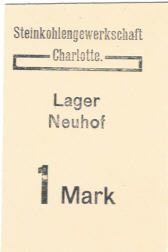 |
|
|
|
|
|
|
Döbeln, Saxony had a POW camp throughout the war. |
|
|
|
|
Issue by the Charlottengrube mining consortium near Czernitz in Upper Silesia, 1916. POWs were often put to work in mines and other industries. |
|
|
|
|
|
|
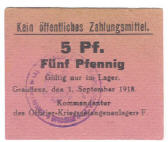 |
|
|
|
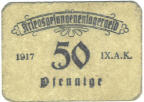 |
|
|
|
|
|
Issue from a POW camp operated by the IX. Army Corps in Güstrow, Mecklenburg. |
|
|
|
|
Issue from a camp near the
mighty fortress of Graudenz in West Prussia. |
|
|
|
|
|
|
 |
|
|
|
 |
|
|
|
|
|
Issue from a POW camp near
Hajmasker in Hungary, 1916. |
|
|
|
A rather pleasant note from Helmstedt's POW camp, in Hannover. |
|
|
|
|
|
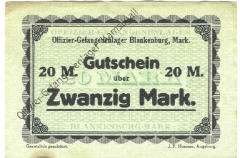 |
|
|
|
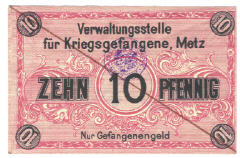 |
|
|
|
|
Issue from Kamstigall in East Prussia, overprinted on issue from Blankenburg camp in the Rhein Pronvinz. |
|
|
|
|
|
|
Issue from a POW camp near the key fortress of Metz in Lotharingia, 1916. |
|
|
|
 |
|
|
|
Zossen, just south of Berlin, was known far less for its POW camps than for its HQ for the German Army and officer's schools. |
|
|
|
Austrian Notgeld, Then and Now |
|
|
|
This is a defunct project, and most pages have already been eliminated to make room for other things. But, please click on the following links to view a sporadic images and details about a few of several hundred villages and towns that issued notgeld for collectors in 1920. The success of this venture opened the door for German collector notgeld the next year, a section of notgeld collecting that is vastly more popular than its Austrian forebear. Nevertheless, every village represented a small piece of its lifestyle or history, and it is sometimes interesting to see how much, or little, has changed. |
|
|
|
Brandstatt
Gars am Kamp
Garsten
Gstoettenau
Hacklbrunn
Hargelsburg |
|
Hart
Hofkirchen a/d Trattnach
Kremsmünster
Mautern
Mining
Waschpoint |
|
|
|
|
|
GWS, 2/01 [rev. 7/04] |
|









































